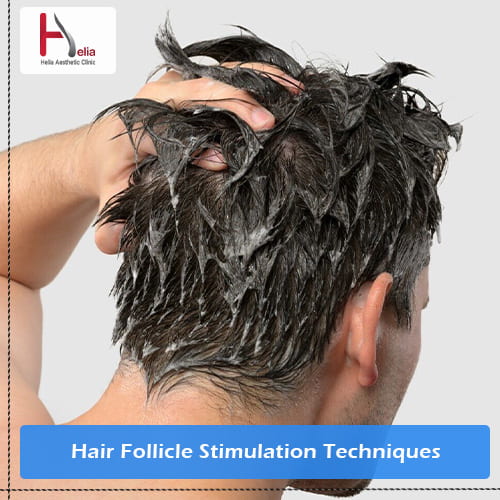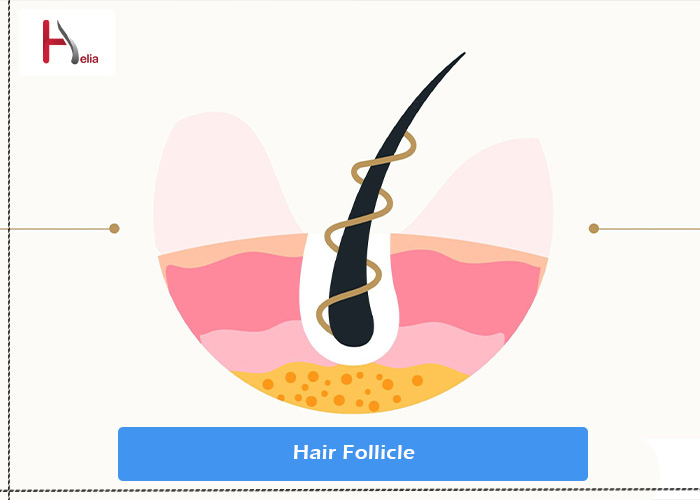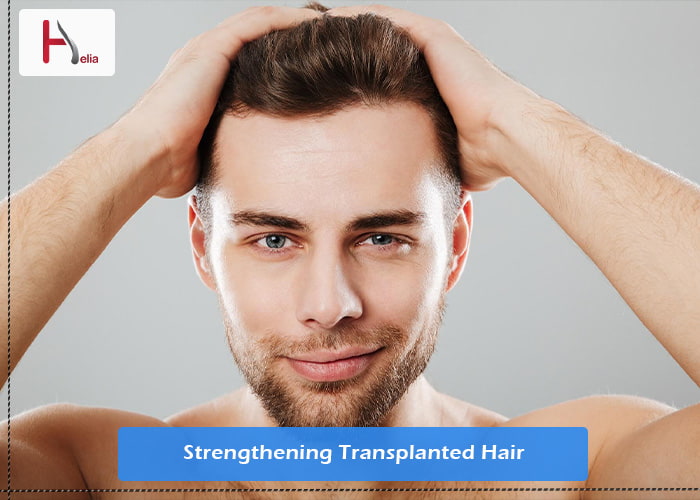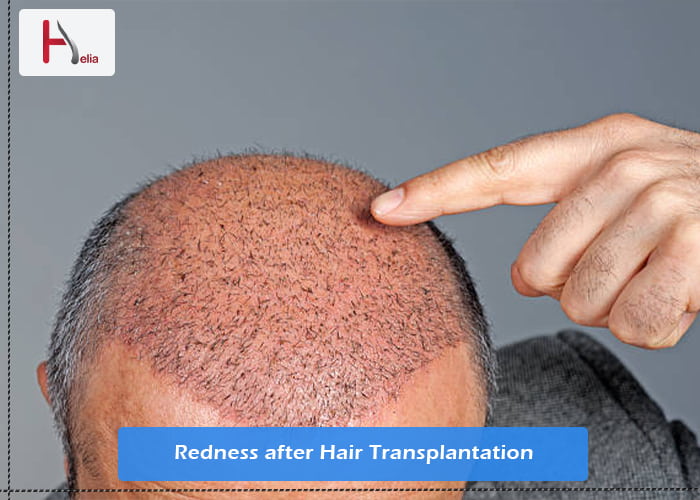Hair follicles are small, pocket-like holes in our scalp, and as the name implies, hair grows through them. Hair that grows through these pores has a specific life cycle and falls out after a while; However, after a few days, we will see the hair follicle grow again. According to the American Academy of Dermatology, an average person has about 100,000 hair follicles on their scalp, which produce more cells, causing hair to come out of the skin and reach the surface. The sebaceous glands, located near the hair follicles, produce oils that nourish the hair and skin and play an important role in regenerating the hair follicles and prolonging their life. In this article, Helia Dermatology Clinic will examine what hair follicles are and how to prevent them from dying; Please accompany us to the end.

What Is a Hair Follicle?
A hair follicle literally means a shaft or pore on the surface of the skin through which hair grows. They are actually tunnel-shaped structures in the epidermis (outer layer) of the skin where hair grows from the ends and its roots feed on the blood of adjacent blood vessels. Hair follicles do not go through the same stages of the life cycle at the same time; This means that some follicles may be in the growth phase while others may be in the resting phase. This is why some of your hair may be growing at the same time but others are falling out.
Hair follicles are not only responsible for the growth of your hair, but also affect the overall appearance of your hair. For example, the shape of the hair follicle indicates whether the hair is curly or straight! The circular follicles produce smooth, bare hair, while the oval follicles produce curly hair.
How Is a Hair Follicle Lost?
On average, your hair grows about 13 millimeters (half an inch) per month. If hair is pulled out of the hair follicle, it can grow back, but it can also be damaged and cause the death of the hair follicle. Some disorders, such as alopecia and decreased blood flow, can cause the follicles to completely stop producing hair. A dead hair follicle is a follicle that can no longer grow hair. In general, the following problems can lead to damage to hair follicles:
- Reduced blood flow to the hair follicles: Lack of proper blood circulation accelerates hair loss because the roots no longer receive oxygen and other nutrients. Therefore, this lack of nutrition leads to the process of shrinking the hair follicle and eventually its death.
- Androgenetic alopecia: This disorder, also known as male pattern baldness, affects the growth cycle of hair follicles on the scalp, slowing down and weakening the hair cycle and eventually stopping it altogether.
- Alopecia areata: Alopecia areata is an autoimmune disease in which the body’s immune system confuses hair follicles with invading foreign cells and attacks them. This disorder often causes batch hair loss and in some cases can lead to alopecia Universalis, which means complete hair loss throughout the body.
- Folliculitis: Folliculitis means inflammation of the hair follicles and can cause the destruction of follicles. Folliculitis often resembles pimples with small red, white, or yellow bumps on the skin and can contain pus. They can be itchy and painful and are often caused by a staph infection.
- Telogen Effluvium: Telogen Effluvium is a temporary but common hair loss that usually occurs as a result of a stressful event and enters the hair follicles into the telogen phase prematurely. This disorder causes thinning and hair loss.

Hair Follicle Stimulation Techniques
Let us be clear at the outset that the initial step in rebuilding hair follicles is crucial, and the good news is that if you still have hair on your head, even if it looks downy, it means that your hair follicles are alive and well and they struggle. Only they may need support, and this support can be achieved through proper nutrition, regulation of hormones, and stimulated blood flow. Simple techniques to stimulate and regrow hair follicle structure include:
- Have a balanced diet rich in nutrients
- Taking appropriate supplements under the supervision of a doctor
- Perform regular exercise to stimulate blood flow to the scalp. Of course, this is not as easy as taking pills and spraying minoxidil on the hair follicles, however stimulating blood flow to the scalp is one of the most promising permanent solutions to improve hair growth, regrowth and reduce hair loss.
- Scalp massage with derma rolling or micro-needling
How to Strengthen Hair Follicles
In general, if the hair follicle is damaged, it is not possible to re-stimulate it, or at least we do not yet know how to stimulate its regrowth. However, there are ways to strengthen the hair follicle:
- Reduce the use of heaters: Hair dryers, straighteners, hot curlers, and other heating conditioners can damage your hair, especially if your hair is thin, dry, or prone to breakage. Excessive heat can weaken the hair and cause serious damage to the follicles and strands. So you need to set your hair dryer and other heated styling tools to a lower temperature to reduce the possibility of hair damage.
- Don’t Forget Vitamins: Hair, like other living parts of the body, needs certain vitamins and minerals to stay healthy and strong. Credible sources have recently shown that nutritional deficiencies can be associated with hair loss and follicular damage. These include vitamin A, group B, vitamins C, D, E, iron and zinc (zinc). Do not forget to consult a doctor before taking any of these vitamins and minerals.
- Blood supply to the hair follicles with massage: Strengthening blood circulation in the scalp can help strengthen the condition of your scalp and also increase blood flow to the hair follicles. According to a valid study in 2016, a 4-minute daily massage on the scalp will increase blood flow, thickness and strength of the follicles. To do this, you can massage your scalp by applying pressure and circular motions with your fingertips for a few minutes. Do this on dry hair or when your hair is wet (just before using shampoo).
- Increase protein intake: Getting enough protein in your diet is important for hair follicles to grow and strengthen because hair follicles are mostly made of more protein. Authoritative sources indicate that a lack of protein in the diet can lead to hair loss and thinning. So use things like eggs, fish such as mackerel and salmon, nuts and seeds, lean meats, spinach and kale, beans and legumes.
- A cold bath can work wonders: Taking a shower with very hot water can cause heat damage to your hair, both at the roots and at the cuticle. Steam in the bath can also open the cuticles of your hair, which can cause dry, frizzy and broken hair. So use cold water for showering to see the effects in a short time and be surprised.
- Aloe vera, the secret to your hair’s survival: Aloe vera is rich in vitamins A and C. These vitamins can help grow healthy cells, including those on your hair. In addition, aloe vera contains vitamin B-12 and folic acid, both of which can play a beneficial role in strengthening healthy hair.
Introducing the Best Shampoo to Strengthen Hair Follicles
In order to produce hair follicles, it is very important to keep your hair clean, but it is interesting to know that most shampoos are made from substances that remove the natural oil from your hair so that they can implement their cleansing effects. One of the harmful substances used in the manufacture of shampoos that can prevent the regrowth of hair follicles is sulfate, the name of which can be found on the label of most hair cleansers. Shampoos that are considered to be healthy and strengthening contain salicylic acid, glycerin, beta-glucan and hydrolyzed keratin.

Vitamins Needed to Strengthen Hair Follicles
While factors such as age, genetics, and hormones also affect the growth and strengthening of hair follicles, the optimal use of nutrients such as vitamins, minerals, and supplements also plays a key role. If you are going to take medicine to get these cases, you should ask your specialist doctor to prescribe the best pill to strengthen your hair follicles according to the condition and characteristics of your hair. Here are 5 nutrients that can be important for hair follicle growth:
- Vitamin A: All cells need vitamin A to grow normally. Hair is no exception to this rule because it has the fastest growth rate of other body tissues. Vitamin A also helps the skin glands make oily substances called sebum; Sebum moisturizes the scalp and helps maintain healthy hair. Sweet potatoes, carrots, pumpkin, spinach and kale are rich in beta-carotene, which is converted to vitamin A. Vitamin A is also found in animal products such as milk, eggs, cod liver oil and yogurt.
- B vitamins: One of the most well-known vitamins to help hair growth is a B vitamin called biotin. This vitamin is absorbed naturally in the body and its deficiency is very rare because it is present in a wide range of foods. However, taking biotin and B-complex helps to produce red blood cells (these cells provide oxygen and nutrients to the scalp. And nourish hair follicles and are important for hair growth). Vitamin B can be obtained from grains, almonds, meat, fish and green leafy vegetables.
- Vitamin C: Free radical damage can stop the growth of hair follicles and cause them to age. Vitamin C is a powerful antioxidant that helps protect against oxidative stress caused by free radicals.
- Vitamin E: Like vitamin C, vitamin E is an antioxidant that can help prevent oxidative stress.
- Iron: Iron helps red blood cells carry oxygen to hair follicle cells. This mineral plays an important role in many bodily activities, including hair growth. Iron deficiency, which causes anemia, is one of the leading causes of hair loss. It is especially common in women
How Do We Know the Hair Follicle Is Alive?
You may be terrified when you look at your hair and see that your scalp is perfectly defined. You definitely want to know what happened to your hair and, most importantly, whether you will see your hair follicles grow back. Hair grows from the follicles on the head, so it makes sense to find out in some way whether those follicles are still alive and able to produce hair. When hair gets thin, it does not necessarily mean that the hair follicles are dead, because sometimes for various reasons, the hair follicles enter a resting phase (the resting phase called the telogen phase) and new hair growth stops temporarily. At this stage, the follicles are alive and will grow back after a while (maybe up to 4 months). In general, just look at your scalp to see if your hair follicles are still active. If you see hair on your scalp (no matter how thin, thin, short or fuzzy), it means that your hair follicles are still alive, stimulating new hair to grow and sprout. You can treat damaged hair follicles by consulting a dermatologist.
Introduction of Hair Follicle Stimulating Drug
Hair follicle proliferation requires the use of special medications that must be prescribed by a specialist doctor after a head examination and special tests (such as hormonal tests). These medications may include the following:
- Minoxidil (Rogaine): Minoxidil without a prescription (OTC) is available in the form of solution, foam (foam) and shampoo. For greater effectiveness, it is recommended topically once a day for women and twice a day for men. Many people prefer the foaming type of this medicine to be used when the hair is wet.
- Finasteride (Propecia): This is a prescription drug for men and it is not recommended for women. Men should take this medicine daily in pill form. Many men who take finasteride experience a reduction in hair loss, and some may show new hair growth. In general, it may take several months to tell if this medicine works for you.
- Other medications: Other oral medication options include spironolactone (Carospir, Aldactone) and oral Dutasteride (Avodart).
Hair Follicles after Hair Transplantation
After proper hair transplantation, the hair follicle is properly placed under the supervision of experienced medical staff and begins to strengthen and stimulate hair formation. After about 9 months to 1 year, people will see the growth of thick and strong hair from their hair follicles. During this period, in order to regrow hair follicles, it is necessary to follow all the care tips advised by your doctor and take your medications to get the best results in terms of density and quality.




